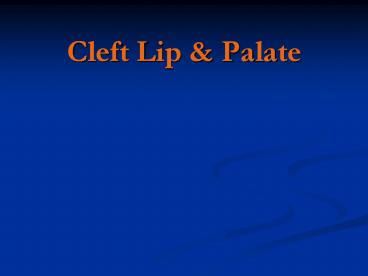Cleft Lip - PowerPoint PPT Presentation
1 / 22
Title: Cleft Lip
1
Cleft Lip Palate
- ??????? ??? ??????
- ?????? ??????? ????????? ??????????
2
introduction
- Facial clefting is the second most common
congenital deformity (after clubfoot). - Affects 1 in 750 births
- Problems are cosmetic, dental, speech,
swallowing, hearing, facial growth, emotional
3
Prevalence
- CL/P is more common than CP and varies by
ethnicity. - CL/P
- High in American Indians and Asians (1/500
newborns) - Low in American blacks (1/2000 newborns)
- Intermediate level in Caucasians (1/1000
newborns) - More common in male
- Isolated CP occurs in only 1/2500 newborns , does
not display variation by ethnicity and more
common in female.
4
Cleft Lip
- Complete closure at 35 days postconception
- 7 weeks from the LMP.
- Lateral nasal, median nasal, and maxillary
mesodermal processes merge. - Failure of closure can produce unilateral,
bilateral, or median lip clefting. - Left side unilateral cleft is the most common.
5
Cleft Palate
- Lack of fusion of the palatal shelves.
- Abnormalities in programmed cell death may
contribute to lack of palatal fusion(?). - Isolated disruption of palate shelves can occur
after closure of the lip - Palatal closure is not completed until 9 weeks
post-conception.
6
emberology
- Primary Palate- Triangular area of hard palate
anterior to incisive foramen to point just
lateral to lateral incisor teeth - Includes that portion of alveolar ridge and four
incisor teeth. - Secondary Palate- Remaining hard palate and all
of soft palate
7
embryology
- Primary Palate
- Forms during 4th to 7th week of Gestation
- Two maxillary swellings merge
- Two medial nasal swelling fuse
- Intermaxillary Segment Forms
Labial Component (Philtrum)
Maxilla Component (Alveolus 4
Incisors) Palatal Component(Triangular
Primary Palate)
8
embereology
- Secondary Palate
- Forms in 6th to 9th weeks of gestation
- Palatal shelves change from vertical to
horizontal position and fuse - Tongue must migrate antero-inferiorly
9
anatomy
- Hard Palate
- Bones Maxilla( Palatine Processes)
Palatine Bones(Horizontal Lamina) - Blood Supply Greater Palatine Artery
- Nerve Supply Anterior Palatine Nerve
10
Anatomy
- Soft Palate
- Fibromuscular shelf attached like a shelf to
posterior portion of hard palate - Tenses, elevates, contacts Passavants Ridge
- Muscles Tensor Veli Palatini(CNV), Levator
Veli Palatini(Primary Elevator), Musculus Uvulae,
Palatoglossus, Palatopharyngeus(CN IX and X)
11
Etiology
- Several agents that are associated with an
increased frequency of midfacial malformation. - Genetics
- Medications phenytoin, sodium valproate,
methotrexate. - With corticosteroids there is no evidence of an
increase in malformations. - Possible association could not be excluded
12
Etiology
- Cigarette smoking
- Noted with mothers of children with facial
clefting, both CL/P and CP. - Teratogenesis has been attributed to hypoxia as
well as a component of tobacco (cadmium). - Alcohol
- Associated with an increased risk of fetal facial
clefting. - Alterations in cell membrane fluidity or reduced
activity of specific enzymes such as superoxide
dismutase. - Folate deficiency
- Contributes to a range of birth defects.
- Evidence is emerging for a similar association
with the development of CL/P.
13
Cleft formation
- Cleft result in a deficiency of tissue
- Cleft lip occurs when an epithelial bridge fails
- Clefts of primary palate occur anterior to
incisive foramen - Clefts of secondary palate occur posterior to
incisive foramen
14
Unilateral incomplete Unilateral complete Bilateral complete
Incomplete cleft palate Unilateral complete lip and palate Bilateral complete
15
Examples of Cleft Palate
- Cleft of Back Soft Palate
- Cleft of Soft Palate
- Cleft of Soft and Hard Palate
- Cleft of Soft and Hard Palate and Cleft Lip
16
(No Transcript)
17
(No Transcript)
18
(No Transcript)
19
(No Transcript)
20
(No Transcript)
21
treatment
- Feeding
- respiratory tract and ear infection
- Orthodontic
- Surgery
22
Surgery
- Cleft lip repair role of ten ( wt 10 pounds,
age 10 weeks and 10 gm /ds litter haemoglobin) - Cleft palate repair at 10 month to 18 months .
- Cp repair before speeking































